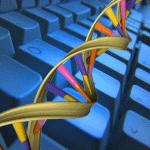Bioinformatics
|
18 august 2014 20:19:37 |
| Dual effects of familial Alzheimer`s disease mutations (D7H, D7N, and H6R) on amyloid ? peptide: Correlation dynamics and zinc binding (Proteins: Structure, Function, and Bioinformatics) |
|
Tweet Short Title: Effects of C-terminal mutations of amyloid ? peptide
Although the N-terminal region of Amyloid ? (A?) peptides plays dual roles as metal-coordinating sites and conformational modulator, few studies have been performed to explore the effects of mutations at this region on the overall conformational ensemble of A? and the binding propensity of metal ions. In this work, we focus on how three familial Alzheimer disease mutations (D7H, D7N, and H6R) alter the structural characteristics and thermodynamic stabilities of A?42 using molecular dynamics simulations. We observe that each mutation displays increased ?-sheet structures in both N and C termini. In particular, both the N terminus and central hydrophobic region of D7H can form stable ?-hairpin structures with its C terminus. The conserved turn structure at Val24-Lys28 in all peptides and Zn2+-bound A?42 is confirmed as the common structural motif to nucleate folding of A?. Each mutant can significantly increase the solvation free energy and thus enhance the aggregation of A? monomers. The correlation dynamics between A?(1-16) and A?(17-42) fragments are elucidated by linking the domain motions with the corresponding structured conformations. We characterize the different populations of correlated domain motions for each mutant from a more macroscopic perspective, and unexpectedly find that Zn2+-bound A?42 ensemble shares the same populations as A?42, indicating the binding of Zn2+ to A? follows the conformational selection mechanism, and thus is independent of domain motions, even though the structures of A? have been modified at a residue level. © Proteins 2014;. © 2014 Wiley Periodicals, Inc. |
| 123 viewsCategory: Biochemistry, Bioinformatics |
 Solution and crystal structure of BA42, a protein from the Antarctic bacterium Bizionia argentinensis comprised of a stand-alone TPM domain (Proteins: Structure, Function, and Bioinformatics) Solution and crystal structure of BA42, a protein from the Antarctic bacterium Bizionia argentinensis comprised of a stand-alone TPM domain (Proteins: Structure, Function, and Bioinformatics)pH Dependence of Conformational Fluctuations of the Protein Backbone (Proteins: Structure, Function, and Bioinformatics) 
|
| blog comments powered by Disqus |
MyJournals.org
The latest issues of all your favorite science journals on one page
The latest issues of all your favorite science journals on one page



